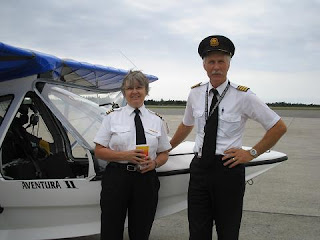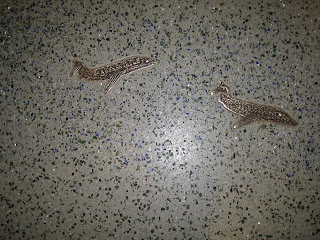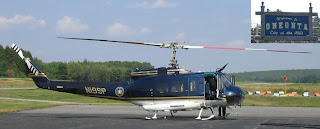Next morning in Maine the weather is grand. The cold front that has been bearing down on us overnight has raced through while we slept, leaving nothing in its wake but a bit of scud cloud.
The coast, quite literally, is clear for our advance to Canada. The only bad news in the weather
is that the tailwind we've enjoyed for the last few days will die down shortly after takeoff.
I have to file a flight plan for the border crossing and we also need to phone Canpass with
notification of our customs arrival so I do the former and hand Lite Flyer my passport to do the
latter. I also need to get a transponder code for the border crossing but the briefer says he
can't assign me one. I have to get it from Boston Center. And he can't give me a number for Boston
Center, I'll have to get it in the air. He gives me the frequency. I'm on the phone a long time
with flight services, but Lite Flyer is also embroiled in a conversation that involves giving out
her credit card information. Eventually we're both done and then I field a call from the
manufacturer, checking up on us. He's amazed that we're preparing to take off for the border
crossing already. We've made great time. The winds have helped, after that first day, plus we've worked hard. I've been lucky not just with weather and maintenance issues but that I haven't once regretted disregarding one of the cardinal rules of ferry piloting: never
bring the owner. Lite Flyer gets up at whatever time I say we have to for weather, eats what's
available, has made no unreasonable demands, never required an early stop for a bathroom break, in
fact has introduced not one minute delay that I recall, and is great company. This would have been
a much less enjoyable trip without her.
We take off into the morning. There is still some low cloud around, which keeps us low at
first. We skirt airspace NOTAMed for an airshow: the NOTAM said Blue Angels, but we only saw a
Pitts Special, and then climb into what remains of our tailwind. Remains? The information we had
that it would only carry us a short way was not correct. If anything, the push increases as we go
north. We're going to be in Canada so fast that Lite Flyer mentions she's almost sorry that the
trip will be over soon.
"It's not over yet," I warn her, keeping an eye out for landing places. Airplanes have a very
keen sense of irony, but this one didn't hear her, fortunately. We skirt Bangor class C airspace
and then make a beeline for Fredericton, on a track that will keep us clear of the artillery range
to its southeast. The tailwind still won't quit, and it's funny how big a difference that makes in
a small airplane. We have a true airspeed of about 65 kts. That makes 200 nm a three hour trip in
no wind. Give us 15 kts on the tail and we cut it to two and a half hours. It takes such a slow
airplane for a moderate wind to make such a huge difference. I make a couple of unsuccessful
attempts to raise US flight services and amend our arrival time, but no one answers. Perhaps we're
too low. within striking distance of the international border I switch over to the Boston Center
frequency and they do hear us, and give us a code. I seem to recall it was 7373, so I show Lite
Flyer to make sure the last two digits aren't both zeroes before making the first digit a 7. We
don't want to create an international incident!
As we approach the international border, we're mainly over uninhabited bus and marsh. Boston
Centre calls us and clears us en route to squawk VFR. "Don't we need to be on frequency with the
discrete code for the border crossing?" I ask. He says no. I tell Lite Flyer, "I guess they don't
need to defend this corner of America from terrorists." I can kind of see why. No offense,
Northern Maine, but you're like Florida without the beaches or sunshine.
We slide across slowly. The border is very wiggly here so I'm waiting to be absolutely sure
we're fully across before celebrating getting this critter to Canada. Lite Flyer calls it first.
And appropriately, it almost immediately gets colder. I put on my jacket, a good trick with these
sturdy harnesses. I also manage to raise Canadian flight services on 126.7 and report our new eta.
I'm looking ahead to where Fredericton must be, waiting to see the airport. I think I see it but I
can't be certain. You know, flying to unfamiliar destinations was harder before the ubiquity of
the GPS. You had to find the destination by pilotage and dead reckoning.
We tune the mandatory frequency and listen to the flight services specialist at the field
herding traffic. (Yup, it's an international port of entry and a provincial capital, but there's
no control tower, just an FSS. The specialist tells traffic the winds and who else is in the area,
and solicits position reports.) It's busy, and the specialist is working hard. They're using a
runway that we're approaching at right angles. Fifteen miles back I have the picture of who is
around. I call in and remember to leave the "Charlie" out of my call sign. The specialist of
course has no trouble with the four letters and when she replies I give my position, eta and state
my intentions to make an overhead join to downwind for the active.
I can see the runway, or at least I have seen enough runways in the past that I see the
environs and know that that is the runway, but I'm waiting for Lite Flyer to find it, and trying
to explain how she will join the circuit. "Just fly straight over the runway, and then hang a left
and you'll be on downwind." She finds it, and then ATC calls back with a wind change. The wind is
now favouring a cross runway and the specialist, who is skilled at telling pilots what to do
without actually giving instructions, asks us if we would prefer a different runway. We would,
even though it means me quickly contradicting myself, "Turn right to parallel that runway." I
hasn't been sufficiently clear and she can't read my mind about which runway. "Turn right here,
more right, more right." I can't usefully tell her to turn to a particular heading, because
there's no heading indicator and the compass and GPS lag too much to be used to roll out. We get
it sorted out, and while I think I did a little bit of direction ("fly direct the point of that
island") for widening out to follow traffic, she planned the turn to final and made an unassisted
landing. It was the best landing of the whole trip and I'm delighted. It's her airplane and she
just brought it to Canada. She's less excited about the triumph than I would have expected. I
think I'm more delighted than she is at the accomplishment. Maybe she's done lots of great
landings before and I haven't seen them. Or maybe she doesn't see her own progress.
We taxi to customs and shut down. Lite Flyer calls 1-888-CANPASS on her cellphone to report our
arrival. We're right on time, because the tailwind that made us early is balanced by a takeoff
delay. She's on hold so she gets up to stretch her legs. I remind her that crossing to the US that
she may not step out of the airplane until asked to by the customs officials, but here she's
allowed to go to the payphone, just don't wander away. I stay in my seat.
She appears to be having some difficulty with the phone conversation, saying "no" and repeating
information that was included in the pre-departure telephone call. She gets up and wanders around.
I watch her on the left side of the airplane, and then I see a customs officer come out of the
building with a clipboard, talking on a cellphone. He's on the right side of the airplane. It's a
very small airplane, so I'm sure they can see each other if they look, but I don't think they're
looking. I wonder if they are talking to each other.
Eventually they hook up and Lite Flyer explains that she is importing the airplane, has already
paid the taxes by credit card. The customs officer walks slowly around the aircraft and there's
something different about the way he does it. It isn't the "what a cool little airplane!" walk
that we've seen over an over again. It's not me looking for anything broken, loose, leaking,
frayed or bent. He stops and pays special attention to the plastic sponson. I think it's the
"where could you hide drugs in this vehicle?" inspection walk. He asks more questions, looks at my
passport and gives it back and then asks if we have any paperwork associated with the purchase.
"That's half the weight of the aircraft!" I quip. Lite Flyer unstraps the knapsack full of
paperwork and she and the customs officer go inside.
Meanwhile a Jazz CRJ has landed and taxied in. I look at it with a bit of a sigh in my heart,
because I interviewed with them and didn't get on, but then I feel the grin on my face and bet
myself that the crew of the CRJ don't have as big a grin right now. In fact, I bet they are
looking at me. Sure enough, they disembark and they're both looking at me. I grin wider and make a
"come on over" gesture. If there's one thing you an say about this airplane, it turns heads. I
think I could park this next to any airplane in the world, and the pilots would get out and come
and see me.
"Where's the water rudder?" the captain asks when he comes up. I explain that the bottom of the actual rudder is in the water after a water landing, so it doesn't need a separate water rudder. He says that the FSS told him to watch for a King Air as he was taxiing in, but that all he had eyes for was this airplane. He has 3500 hours of float time and jokingly offers to trade airplanes. I would, but I have to admit that it's not mine. I think it doesn't matter what you're flying, you always want to be flying what other people have.
The FO is a woman with grey hair, an almost unknown rarity in Canadian airlines. I think she's the first female airline pilot I've met who was not young and perfect. It's secretly inspirational
because there are parts of me that have wondered if I have failed to advance in this industry
because I don't have the right hair or qualify for a second career as the other sort of runway model.

The customs officer comes back and tells me that the airplane is cleared and that I'm welcome
to go inside and use the washroom if I want. That was considerate of him. Lite Flyer is fielding telephone calls from friends and family. I understand there's a member of her family in Fredericton, so I'm waiting to find out if they are meeting us here at the airport.














